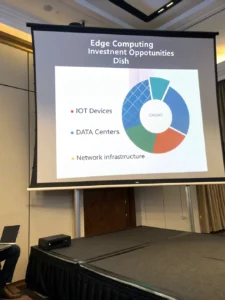Cybersecurity Investments Surge: What Venture Capitalists are Looking for in 2024
The Future is Secure: Navigating Venture Capital Investment Cybersecurity in a Rapidly Evolving Landscape The convergence of technological advancement and escalating cyber threats has created a fertile, yet complex, ground for investment. Venture capital investment cybersecurity is no longer just a niche; it’s a critical component of a thriving digital economy. From startups building cutting-edge security solutions to established companies bolstering their defenses, the demand for cybersecurity talent, innovation, and robust infrastructure is skyrocketing. This post delves into the key trends, investment opportunities, and challenges shaping the future of cybersecurity, particularly within the context of venture capital. We'll explore the factors driving this growth and provide insights for investors and entrepreneurs alike in the ever-evolving world of cyber defense. The Explosive Growth of Cybersecurity Funding: Why Now? The amount of cybersecurity funding being deployed globally is staggering, and the numbers are only projected to increase. Several factors contribute to this surge: Increased Frequency and Sophistication of Cyberattacks: Ransomware attacks, data breaches, and state-sponsored cyber espionage are becoming more common and more devastating, impacting organizations across all sectors. The cost of these incidents is astronomical, driving a desperate need for better defenses. Resources like those provided by CB Insights’ report on cybersecurity trends and investments highlight this trend. Digital Transformation: The rapid adoption of cloud computing, IoT devices, and remote work has expanded the attack surface for cybercriminals, creating new vulnerabilities that require specialized security solutions. Regulatory Pressure: Stringent data privacy regulations like GDPR, CCPA, and others are placing a greater burden on organizations to protect sensitive data, pushing investment in compliance and security tools. AI-Powered Threats and Defenses: The rise of artificial intelligence isn't just impacting offense; it's being leveraged to create more sophisticated security tools, further fueling investment. This environment has attracted significant capital to the sector. In 2023, global cybersecurity spending surpassed $120 billion, and many analysts predict further growth in the years to come. This strong demand for cybersecurity solutions makes venture capital investment cybersecurity an exceptionally promising area. Hot Sectors Driving Venture Capital Investment in Cybersecurity While the overall cybersecurity market is booming, some specific sectors are attracting the most attention from venture capitalists. Here are some of the hottest areas: 1. AI-Powered Cybersecurity Artificial intelligence and machine learning are transforming cybersecurity, enabling faster threat detection, automated incident response, and proactive vulnerability management. Startups developing AI-driven solutions are receiving substantial cybersecurity funding because of their potential to address the growing complexity of cyber threats. This includes: * Threat Intelligence Platforms: Using machine learning to analyze vast amounts of data and identify emerging threats. * Automated Security Orchestration: Automating security tasks to improve efficiency and reduce human error. * Behavioral Analytics: Detecting anomalous user behavior that may indicate a cyberattack. 2. Cloud Security As more organizations migrate to the cloud, the need for robust cloud security solutions is paramount. This segment focuses on protecting data and applications hosted in cloud environments. This includes: * Cloud Access Security Brokers (CASBs): Providing visibility and control over cloud application usage. * Cloud Workload Protection Platforms (CWPP): Securing virtual machines and containers in the cloud. * Data Loss Prevention (DLP) for the Cloud: Preventing sensitive data from leaving the cloud environment. 3. Identity and Access Management (IAM) Strong IAM practices are essential for preventing unauthorized access to systems and data. Startups in this space are focused on enhancing authentication, authorization, and access governance. This includes: * Zero Trust Security: A security model based on the principle of "never trust, always verify." * Biometric Authentication: Using fingerprints, facial recognition, and other biometric data for authentication. * Passwordless Authentication: Eliminating the need for passwords altogether. 4. Endpoint Detection and Response (EDR) EDR solutions continuously monitor endpoints for malicious activity and provide rapid response capabilities. In an era of sophisticated ransomware attacks, EDR has become a crucial security component and is attracting significant cybersecurity funding. 5. DevSecOps Integrating security into the software development lifecycle (SDLC) is gaining traction. DevSecOps tools and platforms help developers build secure applications from the ground up. Challenges and Considerations for Venture Capital Investment Cybersecurity While the potential for returns in venture capital investment cybersecurity is high, there are also challenges that investors need to consider: Talent Shortage: There is a severe shortage of skilled cybersecurity professionals, making it difficult for startups to attract and retain top talent. Rapid Technological Change: The cybersecurity landscape is constantly evolving, requiring startups to innovate continuously to stay ahead of emerging threats. Complexity of the Market: The cybersecurity market is fragmented, with a wide range of solutions competing for market share. Demonstrating ROI: Convincing organizations to invest in new cybersecurity solutions can be challenging, so startups need to demonstrate a clear return on investment. The Evolving Threat Landscape: Cybercriminals are constantly adapting their tactics, so cybersecurity solutions must be resilient and adaptable. Investment Landscape: A Snapshot Here’s a table summarizing the key sectors and investment trends in venture capital investment cybersecurity: Sector Description Investment Trend Key Players (Examples) AI-Powered Cybersecurity Uses AI/ML to automate threat detection & response. High Darktrace, Cylance (now BlackBerry) Cloud Security Securing data & applications in cloud environments. High CrowdStrike, Palo Alto Networks, Zscaler Identity & Access Management Managing user identities & access privileges. Moderate Okta, Auth0, Ping Identity Endpoint Detection & Response Monitoring endpoints for malicious activity. High SentinelOne, Microsoft Defender for Endpoint DevSecOps Integrating security into the software development lifecycle. Growing Snyk, Checkmarx, Veracode The Future of Cybersecurity Investment The demand for cybersecurity solutions will continue to grow for the foreseeable future. Venture capital investment cybersecurity represents a significant opportunity for investors who are willing to identify and support innovative startups. The key to success will be to focus on companies that are developing solutions that are scalable, adaptable, and effective in addressing the evolving threat landscape. Staying informed about emerging technologies, regulatory changes, and the strategies of cybercriminals will be critical for making informed investment decisions. Ready to Stay Ahead? The world of cybersecurity is a dynamic and rapidly changing one. Staying informed about the latest trends and investment opportunities is crucial for success. What are your thoughts on the future of cybersecurity? Share your comments and insights below! You can also explore resources like the latest reports on cybersecurity funding to delve deeper into the topic. Don't forget to share this article with your network!
Share this content:














Post Comment